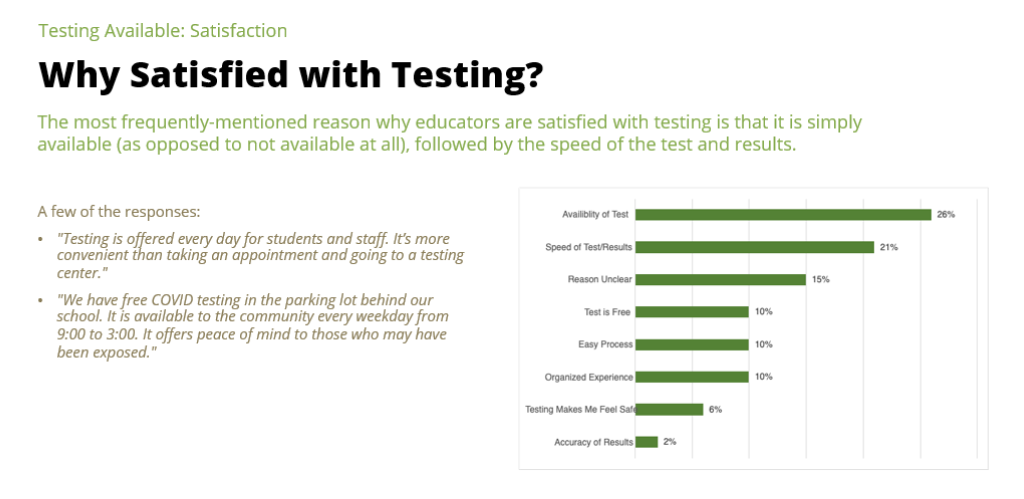
Understanding Attitudes Around COVID-19 Testing in Schools
A mixed-methods study for a biotech company, a client of the User Experience Center (UXC).
Project Summary
During the height of the COVID-19 pandemic, we worked with a biotech company to explore attitudes around COVID-19 testing in schools in 3 geographic areas in the US. This was a mixed-methods study that utilized surveys and in-depth interviews to both gauge the general temperature of testing in schools and understand why they feel that way from multiple perspectives. We surveyed and spoke with hundreds of school administrators, teachers, nurses, and parents, and analyzed their responses to paint a picture of what testing for COVID-19 and other diseases could look like in an educational setting.
The Challenge
A biotech firm approached us about understanding attitudes around COVID-19 testing in schools. Their product is already on the market and available for “free” to schools through the government in many states around the country. However, they wanted to understand, in more depth, the motivations to testing, barriers to participating in testing, and what is working and not working when it came to COVID-19 testing in schools. The data from this project is confidential so I can only speak about it in generalities.
Role and Responsibilities
I acted as a UX researcher on a team of 10. The team included 7 research associate (including myself) and 3 senior researchers. My responsibilities included:
Synthesizing the qualitative findings of the study along with my colleagues (40 interviews)
Connecting findings from in-depth interviews to findings from surveys along with my colleagues
Developing recommendations along with my colleagues
Reporting the findings and recommendations along with my colleagues
The Process
This project was already underway as I started my role at the UXC. The stakeholder interviews, surveys and interview guides were already completed. Because the majority of my involvement was around analyzing and reporting the in-depth interviews and connecting the survey results with the interview results, my focus will be on those topics.
1. In-Depth Interviews
Separate teams worked through analyzing the results of this project. One team worked through the survey results while another team worked through the interviews. These were analyzed concurrently. I was on the interview analysis team. We coded the interviews to find and develop themes that would answer the research questions coming from the internal stakeholders.
We initially separated this by interview persona - meaning that we had separate results for parents, teachers, nurses, etc. When we saw a lot of the personas had similar feelings, we combined them together to create larger, overarching themes in our next iteration.
2. Reporting
I worked on the following reports:
Interview results for 1 geographic area
Interview results for 2 geographic areas combined
Summary results combining interview and survey results
For the interview reports, we summarized our findings under each theme (as described above) and used quotes from interview participants to provide evidence or elaborate on our findings. We went through 2 iterations of the report. The first was much more detailed, with findings from each persona. We found the report too lengthy and had a lot of repetitive information. In the next iteration, we combined findings for all the personas to simplify it and tell a more coherent story.
The summary report combined both survey and interview findings. For this report, we backed up our findings with both qualitative and quantitative data, using survey results and interview quotes as evidence. We provided recommendations for each of the findings.
An example of a slide from the summary report. It includes survey results as well as interview quotes for further explanation.
Outcomes
The client walked away with in-depth findings from both survey and interview results that could help them further their business goals and improve services around their current product. The findings also helped them develop new products for testing for other diseases in schools.
Reflections
This project was my very first foray into the world of user research, and what a foray it was! I joined the UXC just as the previous cohort was leaving the firm and the project was already underway. I very quickly had to get up to speed on the project, understand the the different UX research methods being utilized, and jump in to participate in the project. This was a very large project with many moving parts and I felt like a really important part of the team, even if I was just 1 person out of 10. My goals as a researcher are to conduct and eventually manage more studies of this scope and size.
This project taught me the importance of empathy in the UX research process. Though I don’t have experience in the American school system (outside of University), and don’t have young school-aged children, I listened to parents, teachers, nurses, coaches, and administrators talk about their experiences with the COVID-19 pandemic on a very personal level. Some parents talked about their fears of their children getting sick. Some teachers talked about being overworked, understaffed, and underappreciated. Administrators talked about balancing the wants of the community with protecting their student population. I walked away from that project thankful that I could tell their stories in a time where many felt unheard.

